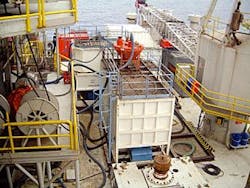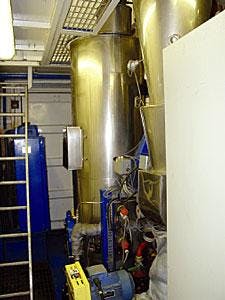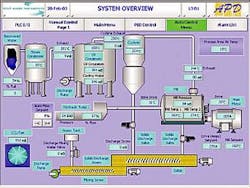A version of the Rotomill hammermill base cutting cleaning unit, specifically designed for offshore operations, has been successfully utilized to clean non-aqueous-based cuttings to levels permitted for discharge under the OSPAR Convention, which regulates discharges to the European marine environment.1
North Sea regulatory driver
The concern for discharging drill cuttings with associated hydrocarbons from diesel and mineral oil non-aqueous-based drilling fluids (NABF) began in the late 1980s. The Paris Commission (PARCOM) Decision 92/2 took steps to reduce the discharge of oil-based drilling fluids to the marine environment. The phased approach ended with the elimination of NADF cuttings discharge in January 1997.
As an alternative, operators utilized water-based fluids, injected the NABF cuttings into dedicated disposal wells offshore, or hauled the NABF cuttings to shore for treatment and disposal.
The PARCOM Decision 92/2 was replaced by OSPAR Decision 2000/3, which incorporated the regulation of synthetic NABF.2 It also established a 1% limit on the quantity of mineral oil NABF that could be retained on cuttings discharged to the marine environment.
This spurred development of technologies such as the Rotomill to meet the discharge criteria. In the course of development, there was continuous consultation with all national authorities to ensure full regulatory compliance.
The Rotomill unit is within the taller container (a) behind the white cuttings storage tank (b) on the deck of the GlobalSantaFe 140 semisubmersible (Fig. 1).
Hammermill technology
In 1995, as a result of the increasing regulatory and environmental concerns, NABF cuttings that could not be discharged or injected were shipped to shore for treatment and disposal. Total Waste Management Alliance PLC (TWMA), with assistance from Mobil North Sea Ltd. (MNSL), researched and ultimately developed the Rotomill for onshore cuttings treatment.
The 1-tonne/hr prototype unit was commissioned in 1996. The electrically powered hammermill unit was able to consistently clean cuttings to less than 1% NABF. A 4-tonne/hr unit was constructed and for more than 6 years has processed more than 50,000 tonnes of NABF cuttings at TWMA's facilities in Aberdeen.
Offshore evaluation
Over the past 2 years, ExxonMobil has utilized the Rotomill offshore to process and clean cuttings on four North Sea wells using semisubmersible mobile offshore drilling units. The Glomar Arctic III drilled three wells in Block 9/19 (Skene field) and the Global Santa Fe 140 drilled one well in Block 9/13a (Nevis field).
The offshore unit was developed from the prototype 1 tonne/hr unit. The offshore unit has the capacity to process NABF cuttings equivalent to a drilling rate of 500 ft/day for an 8.5-in. hole. With 350-bbl cuttings storage capacity, it proved capable of processing the NABF cuttings from both 12.25-in. and 8.5-in. hole sections. In the event of downtime, cuttings can be pumped to tanks on the supply vessel and shipped to shore for processing.
The white tank in the foreground of Fig. 1 is the cuttings storage tank on the GSF 140 rig. The Rotomill is immediately behind, in the taller container. The cylindrical condenser and conical cyclone are housed with the Rotomill in the container (Fig. 2) and is the size of a large centrifuge (Fig. 3).
The cylindrical condenser (left) and conical cyclone (right) are housed with the hammermill (Fig. 2).
Hammermill process
The Mimics touch screen control panel provides a schematic overview of the Rotomill process (Fig. 4).
The cuttings are conveyed from the drilling shakers to the Rotomill, where they are metered into the hammermill through an electronically controlled feed hopper.
The friction from the hammermill and cuttings interactions creates temperatures (260° C.) capable of vaporizing the NABF and water off the cuttings.
The NABF and water vapor then pass to a condenser unit where the NABF is recovered, then to a second condenser where water is recovered. The vaporization and condensation processes occur within a few minutes.
Process efficiency
The cuttings and associated NABF processed through the Rotomill typically consist of 80% solids (drill cuttings), 10% NABF, and 10% water by weight. For every 100 tonnes of cuttings processed, 10 tonnes (80 bbl) NABF are recovered.
In practice, for every 10 tonnes of NABF recovered, 2-2.2 tonnes of fuel are used for the process. In comparison, to handle and haul 100 tonnes of cuttings ashore for treatment requires approximately 3.5 tonnes of fuel.
Recovered oil, water, cleaned cuttings
A total of 1,180 tonnes of NABF cuttings were processed through the Rotomill over the four-well drilling program. The 137 tonnes of recovered NABF, which were tested and shown to be similar to the original base fluid, were recycled into the drilling mud system.
Cleaned powder typically contained 0.05-0.1 wt % NABF and was discharged under a permit. Less than 1 tonne (~6.5 bbl) of NABF was retained on the total quantity of cuttings discharged. Due to the fine nature of the cuttings powder (30 mm median particle size), it was mixed with seawater prior to discharging to assist in dispersion.
Water recovered in the process typically contained 15-50 mg/l. NABF. Some was reused in the mud system, while the remainder was discharged under a permit.
Oil content of the powder and water from the process was monitored daily with an infrared solvent extraction. Samples were also sent for confirmation analysis onshore.
Results from the four trials show that the Rotomill can be operated under various offshore conditions and variable drilling environments. Table 1 provides a summary of the cuttings processing performance.
Safety considerations
Prior to the Rotomill being installed on the rigs, a full hazard and risk assessment was performed. Bridging documents were required between TWMA and the offshore drilling contractor management systems. This was similar to TWMA's onshore installation, where 5 years previously, the Scottish Environmental Protection Agency (SEPA) had to approve the design, fabrication, and operations of the system. The process system is rated as having no emissions. Some of the safety features include: enclosed containers with CO2-purge system, equipment tied into the rig's emergency shutdown, and computer-controlled operations and data management. Two people/12-hr tour and one person for cuttings management operate the entire process.
Using of the Rotomill improves safety performance over the common practice of placing the cuttings into cuttings boxes and hauling them to shore.
This activity carries risks because as many as 3,000 lifts may be required per well, exposing personnel in the process. Using the Rotomill is one way to avoid these lifts.
That same improvement can be applied to the cuttings handling on the transport vessel, dock, trucking operations, and onshore processing facility. The unit adapted for offshore weighs about 30 tonnes and is packed in two 20-ft containers.
Challenges forward
The development unit does not have the capacity, even with storage capabilities on the rig, to process the quantity of NABF cuttings volume generated while drilling at high rates of penetration and larger hole.
To meet that challenge, TMWA has designed two new units. One is capable of processing 6 tonnes/hr and is powered by a 900-kw diesel engine specifically designed for offshore. This unit can process the equivalent of 2,000 ft/day of 12.25-in. hole. The other unit's capacity is 4 tonnes/hr using a 650 kw diesel-powered engine unit and may be operated onshore or mounted on a vessel.
The offshore design allowed the higher capacity unit to be constructed in three containers that occupy only a slight larger area than the prototype (22 ft x 22 ft). In addition, the maximum lift is approximately 22 tonnes. The unit has completed 400 hr commissioning trials onshore and was successful operated offshore.
In March 2003, the OSPAR Offshore Industry Committee (OIC) clarified the status of offshore cuttings cleaning.3 In the UK, monitoring and reporting procedures have been put in place with discussions ongoing in other OSPAR countries. Options are being investigated to extend offshore cleaning for both platform and mobile rigs.
References
1. OSPAR Convention for the Protection of the Marine Environment of the Northeast Atlantic, www.ospar.org.
2. OSPAR Decision 2000/3, www.ospar.org.
3. Offshore Industry Committee (OIC) Summary Record 2003, p. 14, section 3.37 a., www.ospar.org.
The authors
Bob Williamson (Bob.Williamson@exxonmobil. com) is drilling fluids advisor for Mobil North Sea Ltd. He has worked in drilling fluids since 1975, initially as a mud engineer then as a technical services engineer for Magcobar (Magnet Cove Barium), a division of Dresser Industries Inc. that merged in 1986 into M-I Drilling Fluids. In 1988, Williamson joined Mobil and has been involved with new technologies for cuttings treatment and transfer. Williamson earned a BSc Honors at Aberdeen University.
Charlie Gilbertson ([email protected]) is a drilling supervisor for Mobil North Sea Ltd. Currently working deepwater West Africa, Gilbertson joined Mobil in 1998 as a drilling supervisor with 22 years' offshore experience. Prior to that, he worked 16 years with a drilling contractor: 9 years in the North Sea, and 7 years in Vietnam, Indonesia, Malaysia, Borneo, Philippines, China, and Australia. Gilbertson holds an MSc in drilling and well engineering from Univation at the Robert Gordon University, Aberdeen.
Roy Roberts (roy.roberts@ exxonmobil.com) is global drilling environmental coordinator for ExxonMobil Development Co. Roberts joined ExxonMobil in 2002 and has more than 20 years' oil and gas experience, as drilling engineer, environmental manager, and senior environmental consultant. Roberts has an MS in environmental quality engineering from the University of Alaska at Anchorage and a BS in engineering chemistry from the University of Tulsa. He is an SPE member.
Doug Florance (dflorance@ twma.co.uk) is technical sales engineer with Total Waste Management Alliance PLC. Florance has been involved in platform construction, solids control, drilling and completion fluids, and waste management. Prior to joining TWMA, he spent 15 years with BW Mud Ltd. developing mud-mixing systems, well bore clean-up formulations, and operating techniques. Florance received a National Certificate in mechanical engineering at Aberdeen Technical College and Robert Gordons Institute of Technology, now Robert Gordons University. He is an SPE member.










